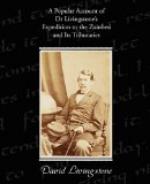A few clumps of the palm and acacia trees appear west of Morambala, on the rich plain forming the tongue of land between the rivers Shire and Zambesi. This is a good place for all sorts of game. The Zambesi canoe-men were afraid to sleep on it from the idea of lions being there; they preferred to pass the night on an island. Some black men, who accompanied us as volunteer workmen from Shupanga, called out one evening that a lion stood on the bank. It was very dark, and we could only see two sparkling lights, said to be the lion’s eyes looking at us; for here, as elsewhere, they have a theory that the lion’s eyes always flash fire at night. Not being fireflies—as they did not move when a shot was fired in their direction—they were probably glowworms.
Beyond Morambala the Shire comes winding through an extensive marsh. For many miles to the north a broad sea of fresh green grass extends, and is so level, that it might be used for taking the meridian altitude of the sun. Ten or fifteen miles north of Morambala, stands the dome-shaped mountain Makanga, or Chi-kanda; several others with granitic-looking peaks stretch away to the north, and form the eastern boundary of the valley; another range, but of metamorphic rocks, commencing opposite Senna, bounds the valley on the west. After streaming through a portion of this marsh, we came to a broad belt of palm and other trees, crossing the fine plain on the right bank. Marks of large game were abundant. Elephants had been feeding on the palm nuts, which have a pleasant fruity taste, and are used as food by man. Two pythons were observed coiled together among the branches of a large tree, and were both shot. The larger of the two, a female, was ten feet long. They are harmless, and said to be good eating. The Makololo having set fire to the grass where they were cutting wood, a solitary buffalo rushed out of the conflagration, and made a furious charge at an active young fellow named Mantlanyane. Never did his fleet limbs serve him better than during the few seconds of his fearful flight before the maddened animal. When he reached the bank, and sprang into the river, the infuriated beast was scarcely six feet behind him. Towards evening, after the day’s labour in wood-cutting was over, some of the men went fishing. They followed the common African custom of agitating the water, by giving it a few sharp strokes with the top of the fishing-rod, immediately after throwing in the line, to attract the attention of the fish to the bait. Having caught nothing, the reason assigned was the same as would have been given in England under like circumstances, namely, that “the wind made the fish cold, and they would not bite.” Many gardens of maize, pumpkins, and tobacco, fringed the marshy banks as we went on. They belong to natives of the hills, who come down in the dry season, and raise a crop on parts at other times flooded. While the crops are growing, large quantities of fish are caught, chiefly Clarias capensis, and Mugil Africanus; they are dried for sale or future consumption.




